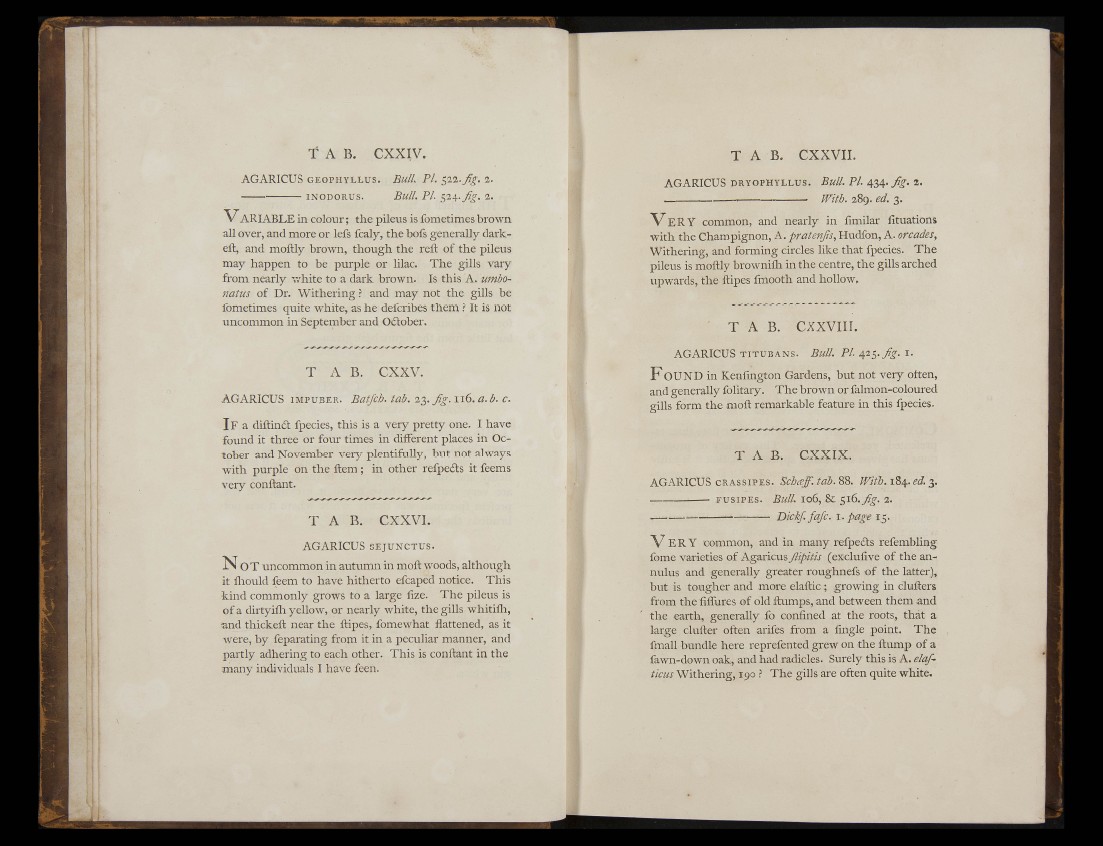
T A B . CXXIV.
AGARICUS GEOPHYLLUS.
INODORUS.
Bull PL 522.//. 1.
Bull. PI. 524. j^'. 2.
VARIABLE in colour; the pileus is fometimes brown
all over, and more or lefs fcaly, the bofs generally darkeil,
and moftly brown, though the reft of the pileus
may happen to be purple or lilac. The gills vary
from nearly white to a dark brown. Is this A. umbonatus
of Dr. Withering ? and may not the gills be
fometimes quite white, as he defcribes them ? It is not
uncommon in September and October.
T A B. CXXV.
AGARICUS IMPUBER. Batfch. tab, Jig. xi6. a.b. c.
IF a diftindl fpecies, this is a very pretty one. I have
found it three or four times in different places in October
and November very plentifully, but not always
with purple on the ilem ; in other refpeds it feems
very conilant.
T A B. CXXVI.
AGARICUS SEJUNCTUS.
N o T uncommon in autumn in moil woods, although
it fliould feem to have hitherto efcaped notice. This
kind commonly grows to a large fize. The pileus is
of a dirtyifli yellow, or nearly white, the gills whitiili,
and thickefl: near the ñipes, fomewhat flattened, as it
were, by feparating from it in a peculiar manner, and
partly adhering to each other. This is conftant in the
many individuals I have feen.
T A B . CXXVII.
AGARICUS DRYOPHYLLUS. Bull. PI. 434. fig, 2.
With. 289. ed. 3.
"VERY common, and nearly in fimilar fituations
with the Champignon, A. pratenfts, Hudfon, A. or cades,
Withering, and forming circles like that fpecies. The
pileus is moftly brownifli in the centre, the gills arched
upwards, the ñipes fmooth and hollow.
T A B . CXXVIÍÍ.
AGARICUS TITUBANS. Bull. PI. ^^Z-J^S- i-
FOUND in Kenfmgton Gardens, but not very often,
and generally folitary. The brown or falmon-coloured
gills form the moft remarkable feature in this fpecies.
T A B. CXXÍX.
AGARICUS CRASSIPES. Scbaff. tab.^^. Wit'h.\Z\.ed.
FUSIPES. Bull. 106, & 516.7^. 2.
Dickf.fafc. X. page 15.
V e r y common, and in many refpe6ls refembling
fome varieties of Agaricus Jlipitis (excluiive of the annulus
and generally greater roughnefs of the latter),
but is tougher and more elaftic ; growing in clufters
from the fiffures of old flumps, and between them and
the earth, generally fo confined at the roots, that a
large clufter often arifes from a fingle point. The
fmall bundle here reprefented grew on the ftump of a
fawn-down oak, and had radicles. Surely this is A. elafticus
Withering, 190 ? The gills are often quite white.